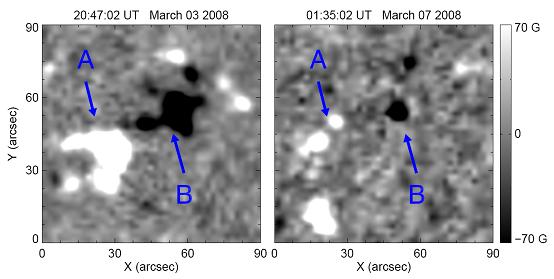Submergence of original magnetic loops is first detected in a coronal hole
Combined with the data from several spacebased instruments, Shuhong Yang et al. investigate magnetic field evolution in coronal holes. They first detect the submergence of initial loops after emergence in a coronal hole. This study has been published in The Astrophysical Journal (Yang Shuhong, Zhang Jun, & Borrero Juan Manuel. 2009, ApJ, 703, 1012).
Coronal holes are low density and low temperature regions in the solar corona. In coronal holes, magnetic fields are dominated by one polarity and open magnetic lines are concentrated. These open magnetic lines extend to the interplanetary space along which plasma escapes, giving rise to fast solar wind. Due to the restriction of observations, not all the properties of coronal holes are well known.
Using observations from the HINODE, STEREO and SOHO, Yang et al. study an equatorial coronal hole region in March 2008. In six days period, the coronal hole was observed with the vector magnetic fields, velocity fields and ultraviolet measurements. The authors focus on the evolution of dipoles in the coronal hole and find that, the opposite polarities of one dipole separate at first, and then cancel with each other due to the submergence of original flux loops, which is first reported in a coronal hole. The evolution of the dipoles affects magnetic field distribution and configuration of the coronal hole. At the late stage of the dipolar evolution, part of the coronal hole, where the dipoles are located, appears as a quiet region. These results will help us to study the changes between coronal holes and quiet regions and to understand the physical mechanism of the solar wind origin and acceleration.

Figure 1. Longitudinal magnetograms from SOHO/MDI. In the coronal hole region, most of the magnetic flux of one dipole disappeared due to the submergence of original loops connecting the opposite polarities (indicated by A and B).

Address: 20A Datun Road, Chaoyang District, Beijing, China code: 100012
Tel: 010-64888708 E-mail: naoc@nao.cas.cn

